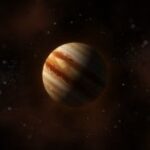Believe it or don’t, but when you peer through a telescope and look at Jupiter’s Great Red Spot you are witnessing what Leonard Nimoy might term the cosmic ballet. Even cooler, you are witnessing something that Galileo never saw, and not because he wasn’t technologically capable. Jupiter’s Great Red Spot has been around for less than four-hundred years. Of course, the idea of a giant storm lasting that long on Earth is unthinkable, but in the cosmic scheme things is akin to about how long a Matt Damon performance sticks in the memory.
Actually, the Great Red Spot is not a cyclone at all, but rather what is know as anti-cyclone. That is to say that Jupiter’s colossal storm flows in an anti-clockwise fashion across an area roughly 24,000 kilometers by 12,000 kilometers. Whether you use metric or the American-only method of measuring distance, that’s one big storm, over twice the diameter of our entire planet. Can you image the devastation if George W. Bush was in charge on Jupiter? Scary indeed.
Robert Hooke is credited with being the first human being to ever see the Great Red Spot on Jupiter, way back in 1664. The redness of the spot, it is theorized, is the result of a reaction of the storm’s churning phosphorus and the sun. The titular color of Jupiter’s storm is enough to make it stand out, but what really has turned it into a star of the solar system (pun intended) is that the top of the storm clouds extend an amazing 8 kilometers above the clouds that surround the storm. What causes the Great Red Spot to keep on churning for centuries instead of-to George W. Bush’s everlasting relief-dissipate after a day or two? Well, sir, it’s because of the thing that promises to make Earth’s own storms keep getting more and more devastating. You see, there used to be these things called land barriers between the Gulf of Mexico and the inland areas that have roughly up lately like Mike Tyson taking on Nancy Pelosi. Only thing is, those land barriers aren’t there anymore due to both natural erosion and man’s evolutionary need to build ten story steel and concrete structures on five feet deep sand. Basically, the natural protections against the ravages of the earth’s fury are being swept away, leaving those who live along the Gulf Coast sitting ducks like they’ve never been before.
Same deal on Jupiter. Only there never has been any land barrier. In fact, there isn’t any solid land mass at all to help break down the storm. As a result, it just keeps going and going like…no, not like that little guy…more like the patience required for Plan #769 in Iraq to show results. Contributing to the long life of the storm that is Jupiter’s Great Red spot is the fact that the storm is continually fueled by Jupiter’s heat. Although it is true over the last century Jupiter’s Great Red Spot actually has been shrinking, without any friction to disperse the energy and a bottomless well of ignition, you may just possibly stand a better chance of seeing an end to American occupation of Iraq than the end of the Great Red Spot.
Don’t hold your breath on either account, however.


